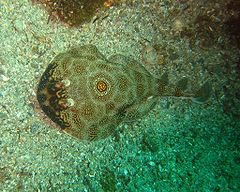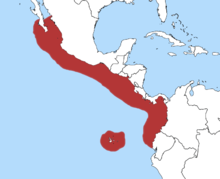- Bullseye electric ray
-
Bullseye electric ray 
Conservation status Scientific classification Kingdom: Animalia Phylum: Chordata Class: Chondrichthyes Order: Torpediniformes Family: Narcinidae Genus: Diplobatis Species: D. ommata Binomial name Diplobatis ommata
(D. S. Jordan & C. H. Gilbert, 1890)
Distribution of the bullseye electric ray Synonyms Discopyge ommata D. S. Jordan & Gilbert, 1890
Narcine ommata Clark, 1936The bullseye electric ray or ocellated electric ray, Diplobatis ommata, is a species of numbfish, family Narcinidae, native to the eastern Pacific Ocean from Baja California to Ecuador. It is most common on sandy bottoms, but is also found over rocky bottoms, in bays, and near rock reefs. The deepest reported occurrence of this species is at 94 meters (308 ft).[1] This species is very similar to the variegated electric ray (Diplobatis pictus), found in the Atlantic Ocean.[2]
This species grows to a maximum length of 25 cm (10 in).[3] It has a rounded pectoral fin disk that overlaps the front margin of the large pelvic fins. The nostrils on each side are divided into two apertures. The teeth are entirely covered when the mouth is closed. The two dorsal fins and caudal fin have rounded tips. The usual coloration is light brown above with numerous spots and diffuse, darker crossbars. There is a prominent ocellated marking at the center of the disk, from which this species derives its common name. Some individuals are plain brown, with a large black spot at the center of the disk.[4]
Like other numbfish, the bullseye electric ray is capable of generating a painful electric shock for defense. It is a solitary, nocturnal species that spends the day partially buried in sand, near rock reefs. At night, it moves into shallower water, using its pelvic fins to "hop" along the bottom. It feeds on small crustaceans such as amphipods and shrimp, as well as polychaete worms. Females mature at under 18.5 cm (7.3 in) in length; the maturation size for males is unknown.[1] Known parasites of this species include the cestodes Acanthobothrium dollyae, A. maryanskii, and A. royi.[5]
Though not utilized by commercial fisheries, the bullseye electric ray was assessed as Vulnerable by the World Conservation Union due to heavy trawling activity throughout its limited range. It is caught as bycatch in offshore shrimp trawls, and its catch rate is likely been underreported due to difficulties in identification.[1]
References
- ^ a b c d de Carvalho, M.R., McCord, M.E. and Bizzarro, J.J. (2006). Diplobatis ommata. In: IUCN 2008. IUCN Red List of Threatened Species. Downloaded on February 15, 2009.
- ^ Ferrari, A. and A. (2002). Sharks. New York: Firefly Books. ISBN 1552096297.
- ^ Froese, Rainer, and Daniel Pauly, eds. (2009). "Diplobatis ommata" in FishBase. February 2009 version.
- ^ Allen, G.R. and Robertson, D.R. (1994). Fishes of the Tropical Eastern Pacific. University of Hawaii Press. ISBN 0824816757.
- ^ Caira, J.N. and Burge, A.N. (2001). "Three new species of Acanthobothrium (Cestoda: Tetraphyllidea) from the ocellated electric ray, Diplobatis ommata, in the Gulf of California, Mexico". Comparative Parasitology 68 (1): 52–65.
Categories:- IUCN Red List vulnerable species
- Diplobatis
- Fish of the Gulf of California
- Western Central American coastal fauna
Wikimedia Foundation. 2010.

